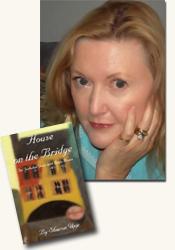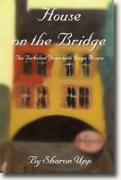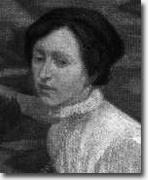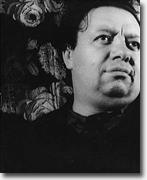author interview
book reviews:
· general fiction
· chick lit/romance
· sci-fi/fantasy
· graphic novels
· nonfiction
· audio books
· author interviews
· children's books @
curledupkids.com
· DVD reviews @
curledupdvd.com
newsletter
win books
buy online
links
home
for authors
& publishiss
for reviewers

|
|||||
 
Sharon Upp discusses her story based on artist Angelina Beloff's ten-year relationship and marriage to Diego Rivera, and how the loss of a child and being in love with a chronically unfaithful man affected her and her art. Interviewer Luan Gaines: What was your inspiration for House on the Bridge Sharon Upp: As a student in Mexico City at the Ibero-Americana I lived in Coyoacan, the same colonial town as Frida Kahlo’s famous blue house. My friend Alberto Valenzuela used to take me there. Afterwards, we would go to a quaint garden for chocolate down a cobbled lane. While a student, I visited art museums in Chapultepec Park. That is when I first saw Frida’s work and was literally taken aback by the ferocious honesty. I decided I wanted to write about her. Why has Angeline Beloff traveled so far from her homeland in 1909? And why has Rivera come? How do they meet? Angeline is an art student in St. Petersburg who dreams of studying in Paris. When both her parents die within a year of each other, she decides to make the trip. Having a regular monthly stipend enables her to study. Rivera is in Paris to attend the free academies in Montparnasse, see the work of Cezanne first hand and produce work to send back to the Governor of Vera Cruz who is his benefactor. A friend of his from Spain introduces him to Angeline in Bruges. Rivera is a charming roué, but Angeline successfully resists him when they first meet in Bruges. Why? Is Diego’s talent part of his attraction? Angeline is too intelligent not to realize who Rivera is...an adventurer...the kind of man her father warned her about. But slowly he charms her with his talent and encyclopedic knowledge of art. It is his mind she is attracted to, I think. How is Beloff’s relationship to Spanish painter Maria Blanchard affected by Rivera’s pursuit of Angeline? How is that situation resolved? Maria Gutierrez y Blanchard goes by Blanchard in France. She meets Diego while studying painting in Spain and is dazzled by him. She is very excited to meet him in Bruges and is hopeful the relationship will deepen. Instead, he chooses her friend. Although initially annoyed and jealous of his attention to Angeline, she later realizes that it is for the best. She does confront Angeline, however. Beloff and Rivera are an integral part of the city’s artistic community in the early 1900s. What is the nature of that community? What is Belle Epoch Paris? Belle Époque Paris is an exciting city where people from around the world gather to enjoy life. It is a glamorous place for those with money. The artistic community lives on the fringes, literally, in Montparnasse and Montmartre, small villages on the outskirts, where they can afford the rent, cafes and bars. (Drinks are tax free in Montmartre.) Lapin a Gil—later Lapin Agile - is a small and raucous bar where Picasso, Modigliani and others meet after long hours at work.
Picasso and Modigliani are great friends of Rivera at first. Rivera looks up to Picasso. He doesn’t believe in God but he believes in Picasso. It is a while before Picasso becomes well-known. Angeline mentions a Russian dealer who buys his work and that is the turning point for him. Being cantankerous, Rivera eventually fights with Picasso, accusing him of copying his work. Modigliani is a notorious drunk who does quick sketches in bars for drinks or quick portraits when he needs money. He isn’t particularly ambitious. The other painters of the quarter recognize an innate, fluid talent in him that he squanders. Rosalie of Rosalie’s Cremerie on Rue Campagne Premier gives him large portions of minestrone with extra pieces of meat when he comes in sober. When he is drunk, she throws him out. He paints a large mural in the restaurant to thank her. Modigliani dies young. He, Angeline and Rivera are still friends. Diego tells Angeline, “Paris is shallow and stuffy… I lack inspiration.” But Beloff loves Paris and her work there. How do they resolve this conflict? Craving Mexico, Diego criticizes Paris. He battles with insecurity and doubts about his purpose. Angeline who is perfectly at home in Paris and doesn’t carry the burden of how much of him is Spanish and how much is Indian, nonetheless sees and understands his struggle with identity. He loves the art of pre-Columbian Mexico and yearns to produce something lasting—he wants to claim it as his own and yet his upbringing has been European. She tells him he needs to spend a year at home sorting it out. If he returns, she will marry him. Does their separation inspire the couple to marry? It seems to me that the year spend apart is very difficult for her. He must miss her because he writes faithfully and does return to Paris. He marries her in Dieppe in 1911. Can you describe the disagreement over the couple’s marital status? Are there documents to prove the legality of the union? Why do you support Beloff’s claim over Rivera’s? Angeline Beloff is listed in many books as his common-law wife but she says very clearly in her autobiography that they were married in Dieppe in 1911. I never looked for documentation because I believe her. He was notorious for denying his responsibility to others, including his daughter Marika by Marievna Vorobiev. Not only is art flourishing in Paris, but so are rumors of war. How does the growing political turbulence affect the artistic community, the Riveras in particular? How do these creative people survive the hardships of war? The Riveras are in Spain when war breaks out. They are having a blissful time in the Baleares when everything changes; each of them loses his/her stipend. The Spaniards are very gracious and offer them a chance to stay rent free when they receive word that Diego’s mother has arrived in Spain. They must leave the islands and decide what to do with her. They have no money and the mother has no return ticket and does not even tell her husband she is leaving. Angeline manages to secure a job painting a coat-of-arms and they send the mother back second or third class. Diego tells Angeline to return to Russia. Though appalled, she remains. They return to Paris where the government has placed a moratorium on rents and canteens are opened to feed the artist community. How does Angeline meet her American friends? Guin, Rosemarie and Athena expose Beloff to a different philosophy of life. Is Diego aware of Beloff’s changing beliefs? Angeline is invited to a salon by some friends who had met Guin and Rosemarie earlier. She begins to learn about Vedanta, nondualism and the importance of watching one’s own mind. She is already somewhat conscious of the hero’s journey which is to tame the wild horses of the mind but she begins to discipline herself with more dedication. It is an internal quest. He notices that she is more cheerful due to meditation and spiritual practice but he is basically too self- involved to pay much attention.
Her American friends help her by including her in their circle of spiritual practice and they offer her a place to stay during the privations of war. Not wanting to leave Diego, she eventually goes to stay with a wealthy woman in a comfortable home when her child falls ill. Everyone believes the child is now safe when the unthinkable occurs. The Americans do what they can but of course, no one and nothing can ever ease the pain. What is the significance of St. Genevieve, patron saint of Paris, in House on the Bridge St. Genevieve is the patron saint of Paris. She prayed to save the city from being invaded by barbarians and the city was saved, 5th century, I believe. There is a little hill where the Pantheon is now where the street names reflect the history but if one isn’t paying much attention, one will miss it entirely. The church there is called St. Stephens and her remains are said to be there. The sad thing is that her convent was torn down and the Pantheon stands on that hill to celebrate the great men of France. She is acknowledged there but the building is not meant to honor her. By having the Vedanta circle meet at that little church and pray to keep the Germans away is like bringing the old story full circle and honoring St. Genevieve. What is the source of the title of your novel, House on the Bridge “House on the Bridge” refers to a painting that they do in Bruges in 1909. She does the drawing and he paints over it and enters it in the Salon. Her engraving of the same house is also entered and they both are accepted. In many ways she is the home that bridges the years of exile for him, the years when he is away from Mexico. The ten-year love affair between Angeline and Diego is played out against a background of art and war. Once she has fallen in love, Beloff is as vulnerable as any other woman, her relationship with Rivera more painful than the hardships of war. Does her art suffer for her love? I believe her art does suffer for her love of him because she slowly begins to take care of him and put her own work second. She is a dedicated painter and engraver, however, she makes his breakfast; he leaves; she cleans up, does laundry, etc. He has absolute freedom to come and go while she takes care of things and then gives herself permission to do her own creative work. When the war progresses everyone’s work suffers for lack of materials. Beloff experiences the familiar anguish of a woman married to a chronically unfaithful man. Does Diego’s infidelity poison the relationship? Does Angeline believe motherhood will bring them closer? Angeline loves him unconditionally for as long as is humanly possible. When she catches him in an undeniably compromising position she has to throw him out. At that point, the relationship is poisoned. She never thinks that motherhood is the solution, quite the contrary. She is afraid that he might throw the child out the window for crying while he wants to work. Her tender heart and the desire for the father of her child to be a part of his life help her to forgive or at least allow him back in their lives. Who is Marievna Vorobiev? How does she affect the already strained relationship between Angeline and Diego? Marievna Vorobiev is a young, wild Russian woman who arrives in Paris looking like a gypsy and wanting to be an artist. She has little talent for art. She actively seduces Rivera and the stories of their brutal physical fights are epic. Though he is attracted by the savage and adventurous nature of his mistress, even he tires of her. The loss of her child is devastating to Beloff. How does she survive this loss? Does her child’s death affect her relationship with Rivera and their future as a couple? She is too devastated to say much about it in her memoir. She paints. I believe it leaves her too bereft to explain in much detail. Diego and she have already reconciled. After the war they have to move because the moratorium on rents is lifted and Diego is impatient with the landlord. So they are both focused on what is before them—the need to find a place to live. The war probably makes them realize that life was too short to cling to grievances..
Yes, absolutely my empathy for her colored the story. I tried to be fair to Rivera and in fact was told that the dialog was too nice to come from his mouth. Actually, when I initially wrote dialog for him it sounded so pseudo-intellectual I cringed. I later read that he said of himself, quoting Zarathustra to the open ocean was kitschy and ridiculous, so perhaps I was capturing a bit of him at that stage. But as for Angeline, I felt great appreciation for her as a person, artist, mother and wife. I hope the work honors her. How have your travels affected your decision to write the story of Angeline Beloff and Diego Rivera? How did you reconcile their very different perspectives, one a Russian in love with Paris, the other a true son of Mexico? My travels definitely affected this story. From the time I was a student in Mexico City many years ago I fell in love with the culture, the friendly people, the art, food, markets, etc. In fact, I wish it were the same today. The marketplace in Oaxaca was practically a pre-Columbian experience. Everything was hand made, dyes were natural, work was exquisite and there was no polyester to be seen. Paris, for me, is one of the most beautiful places on earth and I would love to live there full time. I love to walk, take a coffee on a sidewalk, watch people, visit parks, museums, cheese shops...I could go on and on. Bruges completely enchanted me when I visited with my friends, Susie, Ellen and Wil. I wish I could have spent more time there. I was literally transported by the magic of the Beguinage. I love southern Spain as well. I got there in the late 70s when there was a great deal of political unrest and felt a bit of what that is like. What did you find most challenging in writing House on the Bridge I found writing about Diego the most challenging; his dialog was difficult. It was rewarding living in Paris for a while, writing, walking, living with Angeline and wandering the tiny Rue Campagne Premiere and surrounding area. Now that I’m past my initial fear and self doubt about the quality of the writing...I’m happy that it’s complete; people are telling me they enjoy it; and it can pave the way for the next project. Sharon Upp of Laguna Niguel, California has written for many years, working in Bogota, Colombia as the National Coordinator of English. She has a degree in Spanish Literature and Latin American Studies from Arizona State University and has attended language classes in Paris. She studied two semesters of Pre-Columbian history and art at the Universidad Ibero Americana in Mexico D.F. Contributing editor Luan Gaines interviewed author Sharon Upp, author of House on the Bridge: Ten Turbulent Years with Diego Rivera (see accompanying review), about her book for curledup.com. Luan Gaines/2009.
|
|||||
| fictionnsf/f · comic books · nonfiction · audio newsletter · free book contest · buy books online review index · links · · authors & publishiss reviewerss |
|
| site by ELBO Computing Resources, Inc. | |



